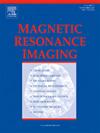Multi-pool model-based amide proton transfer imaging in grading of gliomas and evaluating tumor proliferation: Comparison to apparent diffusion coefficient and magnetization transfer ratio asymmetry
IF 2
4区 医学
Q2 RADIOLOGY, NUCLEAR MEDICINE & MEDICAL IMAGING
引用次数: 0
Abstract
Background
Magnetization transfer ratio asymmetry (MTRasym) is a semiquantitative analysis used for chemical exchange saturation transfer (CEST). Recently, we developed new parameters for CEST imaging using a multi-pool model (MPM) to produce quantitative results. This study evaluated the clinical significance of new parameters on MPM-based amide proton transfer (APT) imaging, the most common type of CEST, by assessing glioma grading and tumor proliferation compared with conventional apparent diffusion coefficient (ADC) and MTRasym.
Methods
25 patients with gliomas underwent MRI. Two-dimensional axial APT imaging was conducted using a single-shot fast-spin echo acquisition at 3 T. Apparent diffusion coefficient (ADC), MTRasym (3.5 ppm), and MPM-based APT imaging parameters were calculated using a region-of-interest analysis. The Ki-67 index was obtained from tumor specimens. The parameters were compared among three glioma grades using one-way ANOVA. Pearson's correlation coefficient was used to assess correlations between the parameters. Receiver operating characteristic analysis determined the optimal cutoff values and assessed diagnostic performances for tumor grades.
Results
Ki-67 index was significantly correlated with APT_T1, MTRasym, and ADC. APT_T1 significantly differed between grades II and III, grades III and IV, and grades II and IV. MTRasym and ADC significantly differed between grades II and III and grades II and IV. APT_T1 showed the largest area under the curve (0.94), followed by MTRasym, ADC, and APT_T2 in differentiating grade IV from other-grade gliomas.
Conclusion
APT_T1 showed the highest potential for differentiating grade IV glioma from other grades. Moreover, APT_T1 may be useful in assessing tumor proliferation and predicting tumor grade.
基于多池模型的酰胺质子转移成像在胶质瘤分级和肿瘤增殖评估中的应用:与表观扩散系数和磁化传递比不对称的比较。
背景:磁化传递比不对称(MTRasym)是用于化学交换饱和传递(CEST)的半定量分析方法。最近,我们开发了用于CEST成像的新参数,使用多池模型(MPM)来产生定量结果。本研究通过与常规表观扩散系数(ADC)和MTRasym比较,评估胶质瘤分级和肿瘤增殖,评估基于mpm的酰胺质子转移(APT)成像(最常见的CEST类型)新参数的临床意义。方法:对25例胶质瘤患者行MRI检查。二维轴向APT成像采用3 T的单次快速自旋回波采集。表观扩散系数(ADC)、MTRasym(3.5 ppm)和基于mpm的APT成像参数通过感兴趣区域分析计算。肿瘤标本Ki-67指数测定。使用单因素方差分析比较三个胶质瘤等级的参数。采用Pearson相关系数评价各参数之间的相关性。患者工作特征分析确定了最佳临界值并评估了肿瘤分级的诊断性能。结果:Ki-67指数与APT_T1、MTRasym、ADC有显著相关性。APT_T1在II级与III级、III级与IV级、II级与IV级之间存在显著差异。MTRasym与ADC在II级与III级、II级与IV级之间存在显著差异。在IV级与其他级别胶质瘤的鉴别中,APT_T1曲线下面积最大(0.94),其次是MTRasym、ADC和APT_T2。结论:APT_T1在IV级胶质瘤与其他级别胶质瘤的鉴别中具有最高的潜力。此外,APT_T1可能在评估肿瘤增殖和预测肿瘤分级方面有用。
本文章由计算机程序翻译,如有差异,请以英文原文为准。
求助全文
约1分钟内获得全文
求助全文
来源期刊

Magnetic resonance imaging
医学-核医学
CiteScore
4.70
自引率
4.00%
发文量
194
审稿时长
83 days
期刊介绍:
Magnetic Resonance Imaging (MRI) is the first international multidisciplinary journal encompassing physical, life, and clinical science investigations as they relate to the development and use of magnetic resonance imaging. MRI is dedicated to both basic research, technological innovation and applications, providing a single forum for communication among radiologists, physicists, chemists, biochemists, biologists, engineers, internists, pathologists, physiologists, computer scientists, and mathematicians.
 求助内容:
求助内容: 应助结果提醒方式:
应助结果提醒方式:


